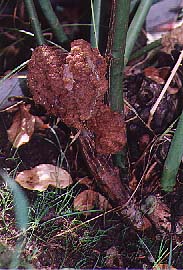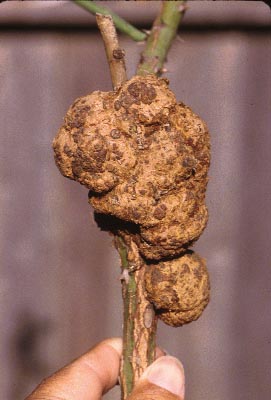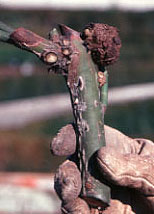


CAUSAL ORGANISM: Agrobacterium spp.
This is really the only serious bacterial disease of Rose. The bacteria is found world wide wherever roses are grown and is especially severe in loose sandy or sandy loam soils.



SYMPTOMS: On roses the symptoms of overgrowths can occur at the crown, bud union or on the roots. Galls are usually round to irregular in appearance and may have a rough exterior. Upon cutting across a gall, a disorganized callus type of tissue is commonly found. The portions closest to the exterior usually contain the actively growing bacteria. However, once the tumor inducing plasmid is introduced into a plant disease can occur without the presence of the vectoring bacteria.
DISEASE CYCLE: The bacteria causing the disease are soil born and can survive in soils for many years. When roses are planted in infested soil any wound sites on the roots or crown offer points of entry for the bacteria. Once in the host the tumor inducing principle carried on a small circular portion of DNA is incorporated into the plant cell and a overgrowth begins to form. In some plants the bacteria can be systemic and galls may begin to form at many sites on the plant. As the galls develop callus tissue is laid down which is susceptible to other types of breakdown, decay or sloughing. In this way the soil around a plant can become infested with the bacteria. The bacteria survives many years in the soil and can be moved with water or other infected plant parts.
CONTROL: Always inspect new plants thoroughly before placing them in your garden. Since wounds can be infected at the time of digging some plants may have latent infections which could become evident several years after they were planted. If crown gall is detected the plant may survive many years but could serve as a reservoir for the bacteria. Thus, removal of the plant as well as adjacent soil is recommended. In some cases soil fumigation is used to kill the bacteria in the soil, but this is only effective where relatively porous and dry soils are involved. Plant surgery is also an option on specimen roses but precautions should be taken to sterilize cutting equipment before and after use. These plants should probably be removed from the garden and watched closely for further development of disease. Any plants propagated from infected material should also be watched for the development of galls resulting from systemic contamination.
Horst, R. K. 1983. Compendium of Rose Diseases. The American Phytopathological Society, St. Paul, Minnesota. Pp. 23-26 and Color Plates 39-42.
![]()
If you have any questions or constructive comments, I would love to hear from you, please send e-mail to Baldo Villegas
[ Home ]
[ Rose Pests Master List]
[ Rose Diseases ]
[ Insect, Mites, and other Animal Pests ]
[ Abiotic Rose Problems ]
[ Weed Pests ]
[ Hawaii Pests ]
[ The Good Guys ]
[ Help! Rose IPM ]
[ Horticulure Links ]
Copyright© 1995-2002 by Baldo Villegas
Last updated: January 21, 2002